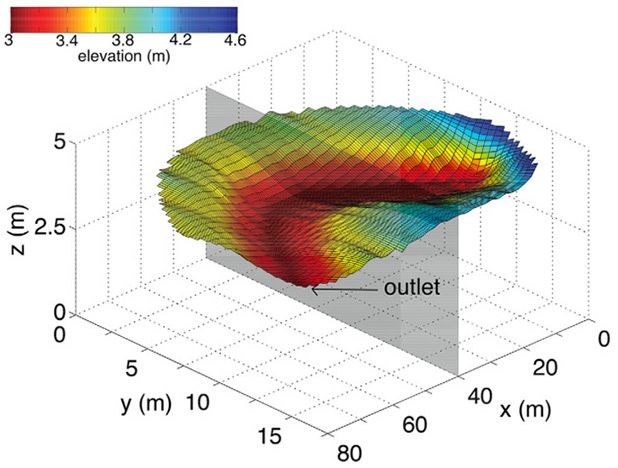Evaluation and Building Confidence in Hydrologic Models
Published on by Water Network Research, Official research team of The Water Network in Academic
Scientists evaluate seven models to understand how each model agrees and differs.

Surface elevation for one of three intercomparison problems in coupled surface/subsurface hydrology. This problem focused on comparing results for a rainfall/runoff experiment in a small drainage ditch to the participating model solutions. I mage courtesy of researchers (S. Kollet et al.)
The Science
Understanding water availability and quality for large-scale surface and groundwater systems requires simulation. Scientists have developed many numerical models to address these simulation needs. How do these models differ in their portrayal of these water-based systems?
To answer that question, seven different modeling teams from the United States and Europe exercised their models to develop a common set of benchmarks. With the benchmarks, they can better understand how each of the models agrees and differs.
The Impact
Intercomparison benchmark challenges build confidence in the choice of model used to answer a specific scientific question. The challenges also illuminate the implications of model choice. How? They force modeling teams to know the strengths and weaknesses of their own and competing models. This understanding leads to more reliable simulations and improves integrated hydrologic modeling.
Summary
Following up on a first integrated hydrologic model intercomparison project several years ago, seven teams of modelers, including two teams supported by the Interoperable Design for Extreme-scale Application Software (IDEAS) project, participated in a second intercomparison project. Teams met at a workshop in Bonn, Germany, and designed a series of three model intercomparison benchmark challenges.
The challenges focused on different aspects of integrated hydrology, including a hillslope-scale catchment, subsurface structural inclusions and layering, and a field study of hydrology on a small ditch with simple but data-informed topography. Parameters were standardized, but each team used their own model, including differences in model physics, coupling, and algorithms.
Results were collected, stimulating detailed conversations to explain similarities and differences across the suite of models. While each of the models share a common underlying core capability, they are focused on different applications and scales, and have their own strengths and weaknesses. This type of effort leads to improvement in all the codes. It also improves the modeling community’s understanding of simulating integrated surface and groundwater systems hydrology.
Research Article 'The integrated hydrologic model intercomparison project, IH-MIP2: A second set of benchmark results to diagnose integrated hydrology and feedbacks' accessible HERE
Source: US DOE
Media
Taxonomy
- Modeling
- Hydrology
- Hydrology
- Hydrologist
- Social Hydrology
- Hydrological Modelling
- Hydrology Cycle